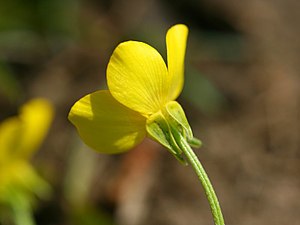βατράχιον
Ἴση λεαίνης καὶ γυναικὸς ὠμότης → Feritas leaenae quanta, tanta et feminae → Der Löwin Wildheit ist die selbe wie der Frau
English (LSJ)
τό,
A Ranunculus, Hp.Nat.Mul.32, Dsc.2.175 (who incl. Ranunculus asiaticus, Persian buttercup, garden ranunculus, βατράχιον χρυσάνθεμον Gp.2.6.30, and Ranunculus sardous, hairy buttercup, hairy crowfoot, cf. Dsc.Alex.14).
II = βάτραχος I, Paus.9.21.1.
III = βάτραχος III, Ptol.Phas.p.27H., al.
IV malachite, Syn.Alch. p.64B.
Spanish (DGE)
-ου, τό
• Alolema(s): βατράχιος Phys.A 140.8; βατράχειον Gal.14.337
I ranita, rana τὰ βατράχια τὰ ἐν ταῖς λίμναις Paus.9.21.1, αἷμα τοῦ βατραχίου Gal.14.414, cf. 394.
II 1bot. ranúnculo, Ranunculus sp., n. genérico que comprende varias especies de plantas, Hp.Nat.Mul.32, Dsc.2.175, Alex.praef.p.14, Gal.l.c., Paul.Aeg.7.3 (p.200), Gp.2.6.30, cf. Phot.β 98
•ranúnculo asiático, Ranunculus asiaticus L., Dsc.l.c.
•sardo, Ranunculus philonotis Ehrh, Dsc.l.c.
•abrojos a cuatro, Ranunculus muricatus τρίτον σφόδρα μικρὸν καὶ δύσοσμον Dsc.l.c.
•hierba lagunera, Ranunculus aquatilis L. τέταρτον ... ἄνθη γαλακτίζον Dsc.l.c.
2 tinte de color verde Phot.β 98.
III mineral. malaquita Syn.Alch.p.64
•como n. de una piedra india, quizá la misma Phys.l.c.
IV astr. ranilla parte de la pezuña del caballo, aquí ref. a la constelación Centauro, Ptol.Phas.p.27.
German (Pape)
[Seite 439] τό, Froschkraut, ranunculus, Hippocr.; Paus. 9, 21, 1.
Greek (Liddell-Scott)
βατράχιον: τό, ranunculus, ἀγριοσέλινον, πολυάνθεμον, Ἱππ. 570. 43, κ. ἀλλ., Διοσκ. 2. 206. ΙΙ. = βάτραχος 3, Πτολ.
Wikipedia EN
Ranunculus asiaticus, the Persian buttercup, is a species of buttercup (Ranunculus) native to the eastern Mediterranean region in southwestern Asia, southeastern Europe (Crete, Karpathos and Rhodes), and northeastern Africa.
It is a herbaceous perennial plant growing to 45 cm tall, with simple or branched stems. The basal leaves are three-lobed, with leaves higher on the stems more deeply divided; like the stems, they are downy or hairy. The flowers are 3–5 cm diameter, variably red to pink, yellow, or white, with one to several flowers on each stem.
It is a protected species in some jurisdictions, including Israel.
Ranunculus sardous is a species of buttercup known by the common name hairy buttercup. It is native to Europe and it can be found in many other areas of the world, including parts of the United States and Australia, as an introduced species and a roadside and lawn weed. It grows in many types of disturbed habitat, especially in moist areas. It is an annual or biennial herb producing a mostly erect, hairy stem up to half a meter tall. The hairy leaves are usually divided into three leaflets which are borne on petioles a few centimeters in length. The flower has usually five yellow petals each up to a centimeter long and five reflexed sepals. The fruit is an achene borne in a spherical cluster of up to 35.


